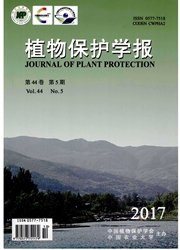

 中文摘要:
中文摘要:
为了明确广东、海南荔枝采后主要病害及其发生和危害情况,从两省荔枝主产区取果,在常温贮藏条件下观察荔枝采后病害的发生情况,测定荔枝果皮上炭疽病菌潜伏侵染率及其对荔枝采后生理变化和贮藏效果的影响。结果表明:荔枝采收后在28℃下贮藏,炭疽病、霜疫病和酸腐病的发病率分别为95.3%、6.5%和8.2%。炭疽病在采后3—4天开始表现症状,7天后发病率为60.8%~100%,9天后发病率为83.1%~100%,该病害是引起荔枝采后腐烂的主要病害,其病原菌主要来自采前潜伏侵染。从幼果果皮上可分离出潜伏侵染的炭疽病菌,随着果实的生长,果皮上的潜伏侵染率不断上升,到采收时炭疽病菌潜伏侵染率达到90%左右。炭疽病菌潜伏侵染率较高的荔枝果实。其采后呼吸速率、乙烯释放量、果皮丙二醛含量均显著升高,褐变腐烂较快,贮藏效果较差,即使在采后用杀菌剂处理,防治效果也不明显。采收时荔枝果皮上炭疽病菌潜伏侵染率越低,贮藏效果越好。在荔枝果实生长期间喷雾2—3次杀菌剂可显著地降低炭疽病菌潜伏侵染率,减轻荔枝采收后炭疽病的发生严重程度,提高荔枝贮藏效果。
 英文摘要:
英文摘要:
To learn the developments of the main postharvest diseases on litchi (Litchi chinensis Sonn. ) fruits collected from the main production areas in Guangdong and Hainan Provinces and the effects of the diseases on storage of the fruits, the developments of the diseases of the fruits stored at room temperature (28℃) were observed and the latent infection rate of the pathogen of anthracnose caused by Colletotrichum gloeosporioides Penz. in the pericarp was tested, and the effects of the infection of the disease on postharvest physiology and storage life of the fruits were studied. The disease occurrence rates of anthracnose, downy blight caused by Peronophythora litchii Chen ex Ko et al. and sour rot caused by C, eotrichum candidum Link were 95.3%, 6.5% and 8.2% respectively. The symptom of anthracnose of the fruits was found to appear on 3th or 4th day after harvest. The incidence of anthracnose was 60.8% to 100% and 83.1% to 100% respectively as the fruits were stored for 7 days and 9 days. The anthracnose was the main disease causing postharvest decay and its pathogen came mainly from the fruit with latent infection before harvest. The pathogen of latent infection was isolated from the pericarp of the young fruits; the rate of latent infection in the pericarp about 90% at harvest. In general, the was increased gradually with the growing of the fruit, reaching to postharvest physiological changes were quite evident. The respiration rate, ethylene production and malondialdehyde content were all obviously increased in the fruits with higher rates of the latent infection of the fungus , causing more serious postharvest decay and browning. The anthracnose on the fruits with high rate of latent infection could not be evidently controlled by using fungicide after harvest. The lower the latent infection rate of the fruit, the better it was for storing. The rate of latent infection of the pathogen, postharvest decay and browning of the fruits were found to be reduced markedly by spraying fungicide twice or three
 同期刊论文项目
同期刊论文项目
 同项目期刊论文
同项目期刊论文
 期刊信息
期刊信息
